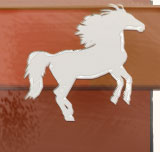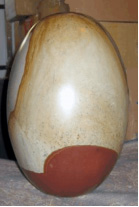
In This Issue: |
 In this issue, we talk about Shiva Lingams. Personally, I have about 20 of these stones. Two are over 100 pounds and most others are 5-10 pounds. Many can be found that are small enough to be made into a pendant or to carry in a pocket or pouch. I use them when I hope to rebalance a persons ability to be centered enough to find the courage to manifest the desired life they seek. The recent Vision questing workshop was a powerful transformational experience. The healing lands and water were amazing. 2009 Workshops In 2009, I will be doing several workshops at Bethel Horizons near Dodgeville, Wisconsin. January 8-11 we will be doing a four day Crystal Layouts workshop where we are doing hands-on practice all four days. March 5-8, we will be offering a Medicine Wheel integration workshop, where those that have completed the four workshops on the medicine wheel will be brought together to integrate all that we have learned. This should be very powerful. October 30 - November 1, we will be doing the Dragon Workshop over Halloween. This is an amazing transforming workshop to ally with your internal dragons. Contact Marie Smith at marie@hawkrdg.org I hope you find something in this newsletter that talks to your soul. If so, please send it along to someone that might be interested. Bountiful Blessings xxxxxxxxxxxxxxxxxxxxxxxxxxxxxxxxxxxxxxxxxxxxxxxxxxxxxxxxxxxxxxxxxxx Stones
Etymology The Sanskrit term transliterated as linga has many meanings, generally as a mark, sign or characteristic. It has a number of specific uses in Sanskrit that are derived from this general meaning. An example of the use of the word linga in general Sanskrit usage to represent the concept of "sign" occurs in the Bhagavad Gita and is translated by Swami Gambhirananda as "O Lord, by what signs is one (known) who has gone beyond these three qualities?" and by Winthrop Sargeant as "By what marks is he recognized, Who has transcended these three qualities, O Lord?". An example of use of the word linga as a technical term in philosophy describes the role of attributes in recognition of objects perceived by the senses:
In Tamil ilingu literally means "home is here", denoting a mound of clay Goddess Uma made to symbolize Mount Kailas and worship God Shiva in it. Ken Harsh notes the Shiva Lingam as “The sacred stone of the East, a container for the duality of God's holy spirit and an embodiment of the creation; a vessel for God's energies. The best stone for balancing male and female energies, in fact, all energies, in today's world.” Source: Ken Harsh, Karma Crystal Guides to Stones, 1995. The word lingam means sign, but it should be noted that its root is the same as that of the langala (plough), a root common to the words for spade and phallus. Thus, the lingam is very definitely a phallus and symbol of procreation. Yet, it should be stressed that it is totally devoid of erotic overtones. The subtle shape known as the lingam-sharira is always spring of life.
Fertilization of the Earth ideally finds expression in natural lingams with their own existence as standing stones on mountain peaks, such as the lingaparvarta of Funan and Champa. These most forcefully conjure up Jacob's Bethel or Beith-el, the House of God, which the patriarch anointed with oil in the same way as lingams are anointed with water. The symbolic kinship between the egg and the lingam is demonstrated, furthermore, by the fact that the swayambhuva-lingam is none other than the OMPHALOS or navel of the world which contains within itself every potential manifestation. In Japan, stone carvings or pottery models of miniature phalli are buried to ensure fruitful harvests. The lingam is both a central and an axial symbol. The lingam of light, which Shiva made manifest and of which Brahman-as-boar sought the base and Vishnu-as-goose sought the tip, corresponds to the World axis and this is why Vishnu and Brahma are regarded as the guardians of the zenith and nadir respectively. In many temples built in the shape of a mandela, some of the best examples being found at Angkor, the central lingam is surrounded by eight minor lingams corresponding to the eight essences of Shiva, to the four cardinal and their intermediary points of the compass and to the eight graha round the Sun. This is not the only instance in which Shiva, generally associated with the Moon, plays a solar part.
In Indian alchemy, the lingam is composed of mercury. This is because alchemy derived from Shiva and, as mercury corresponds to the MOON, it consequently corresponds to Shiva. It may also be noted that the lingam symbol seems to subsist in the Cambodian popil ceremony of circumambulation during which a tray (yoni) surmounted by a lighted candle (lingam) is carried processionally. It is very likely that among those who adore the lingam of Shiva, a great many see it only as an archetype of the generative organs; but there are others who look to it as a sign, an image of the rhythmic creation and destruction of the universe which expresses itself in forms, and periodically returns to its primal, pre-formal unity, before being born. Source: Jean Chevalier and Alain Gheerbrant as translated by John Buchanan-Brown, A Dictionary of Symbols, 1969 "The source of liberation is pure consciousness, the awareness of our real Self. The linga in the head is the seat of this pure consciousness. The linga is a stone symbol in the shape of an egg which is the iconography for Shiva as Absolute Potential. It is egg-shaped to represent the unity of the universe-- its internal consistency and its formless presence in all directions. Thus, the linga has no corners or edges; it is all Om. It has no face because pure consciousness has no face. The linga in the head corresponds to the medulla oblongata, or the brain stem, at the junction between brain and spinal column. This is the still point in the head, the place where the ida, pingala, and the shushumma meet... the Abode of Shiva, the doorway to God." (From The Sky of Mind p 250) "Shiva-Shakti is pure consciousness, the union of pure potential and pure energy that forms the dynamic stillness in the heart of the universe..." p. 251 (identifies Shiva as the male polarity and Shakti as the female-- often symbolized by Shiva and Shakti pictured in sexual union bliss). xxxxxxxxxxxxxxxxxxxxxxxxxxxxxxxxxxxxxxxxxxxxxxxxxxxxxxxxxxxxxxxxxxx Find out more about workshops, retreats, and resources at www.onewhitehorsestanding.com. xxxxxxxxxxxxxxxxxxxxxxxxxxxxxxxxxxxxxxxxxxxxxxxxxxxxxxxxxxxxxxxxxxx Notice This is a shamanic newsletter and is intended only for educational and informational purposes. Any person needing therapeutic support should contact a mental health professional immediately.
|

 The term lingam is sometimes used synonymously for shivalingam, a specific type of icon or altar representing the god Shiva.
The term lingam is sometimes used synonymously for shivalingam, a specific type of icon or altar representing the god Shiva. The base of the lingam, which is concealed within its plinth, is square, the central section is octagonal and the upper part cylindrical. These sections correspond respectively to Brahman (the creator), Vishnu (the preserver), and Rudra, as well as to Earth, the intermediate world and Heaven. In its entirety, the lingam is not an attribute of Shiva (the destroyer), but is
The base of the lingam, which is concealed within its plinth, is square, the central section is octagonal and the upper part cylindrical. These sections correspond respectively to Brahman (the creator), Vishnu (the preserver), and Rudra, as well as to Earth, the intermediate world and Heaven. In its entirety, the lingam is not an attribute of Shiva (the destroyer), but is  In Yoga, the lingam is an axial symbol. Standing in the middle of the root-center which corresponds to the yoni (womb), it is pictured as a light lingam around which is entwined the kundalini-serpent. This lingam is the power of knowledge, knowledge being born from the union of lingam and yoni. In the course of the yogic experience, the column of light rises to the crown of the head and passes beyond it. It is identified with Shiva's flaming lingam.
In Yoga, the lingam is an axial symbol. Standing in the middle of the root-center which corresponds to the yoni (womb), it is pictured as a light lingam around which is entwined the kundalini-serpent. This lingam is the power of knowledge, knowledge being born from the union of lingam and yoni. In the course of the yogic experience, the column of light rises to the crown of the head and passes beyond it. It is identified with Shiva's flaming lingam. Shiva is thought of as "masculine" in nature, yet the stones are often referred to as having feminine energy (which may be more from the water they are formed in then the nature of what they symbolize). This definition of the Shiva Lingam was found in a commentary on the words of a Saint from India named Nityananda. The commentator described it this way:
Shiva is thought of as "masculine" in nature, yet the stones are often referred to as having feminine energy (which may be more from the water they are formed in then the nature of what they symbolize). This definition of the Shiva Lingam was found in a commentary on the words of a Saint from India named Nityananda. The commentator described it this way: